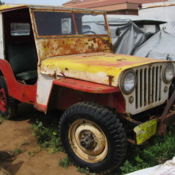1949 Willys-Overland Jeep CJ-3A
| Make: | Willys |
| Model: | Jeep CJ-3A |
| Type: | Convertible |
| Trim: | Custom body, Convertible |
| Year: | 1949 |
| Mileage: | 92,011 |
| VIN: | CJ3A19951 |
| Color: | Green |
| Fuel: | Gasoline |
| Transmission: | T-90 transmission and Dana 18 transfer case |
| Drive type: | Manual |
| Interior color: | Black &- Beige |
| Vehicle Title: | Clear |
| Item location: | Steamboat Springs, Colorado, United States |
| Extras |
|
Convertible |
| Listed by | Private seller |
Description of 1949 Willys Jeep CJ-3A |
| The Willys-Overland CJ-3AThe Willys-Overland CJ-3A was introduced in 1949 and was in production until 1953 when replaced by the CJ-3B. It was powered by Willys' 60 HP L-134 "Go-Devil" 4-cylinder engine. with a T-90 transmission and Dana 18 transfer case. a Dana 25 front axle and Dana 41 or 44 rear axle. It featured a one-piece windshield with a vent as well as wipers at the bottom. The CJ-3A had beefed up suspension (10 leaf) to accommodate the various agricultural implements that were being built for the vehicle. Another difference was a shorter rear wheelwell (the wheelwell from the top front edge to the rear of the body is 32 in (810 mm) on the 3A compared to 34 in (860 mm) on the 2A) and moving the drivers seat rearward. A bare-bones Farm Jeep version was available starting in 1951 with a poser takeoff. 131. 43 CJ-3As were produced before the series ended in 1953. About 550 of the CJ3-A were assembled by Mitsubishi as the J1/J2 in late 1952 and early 1953. exclusively for the Japanese police and forestry agency. World War II and the JeepA Willys MB. better known asJeep. at Military Vehicle Show. War Memorial Museum. Newport News. VA. Sun. . Sept. 24th. 2006Willys-Overland was one of several bidders when the War Department sought an auto maker that could begin rapid production of a lightweight truck based on a design by American Bantam. In 1938 Joseph W. Frazer had joined Willys from Chrysler as chief executive. He saw a need to improve the firm's 4-cylinder engine to handle the punishment to which the Jeep would be subjected. This objective was brilliantly achieved by ex-Studebaker chief engineer Delmar "Barney" Roos. who wanted:"An engine that could develop 15 horsepower at 4. 00 r. p. m. and run for 150 hours without failure. What he started with was an engine that developed 48 horsepower at 3. 00 r. p. m. . and could run continuously for only two to four hours . It took Barney Roos two years to perfect his engine. by a whole complex of revisions that included closer tolerances. tougher alloys. aluminum pistons. and a flywheel reduced in weight from fifty-seven to thirty-one pounds". Production of the Willys MB. better known as Jeep. began in 1941. shared between Willys. Ford and American Bantam. 8. 98 units were produced that year. and 359. 51 units were produced before the end of World War II. Willys-Overland ranked 48th among United States corporations in the value of World War II military production contracts. In total. 653. 68 military Jeeps were manufactured. The Willys-Overland CJ-2A (Precursor to the CJ-3A)After the war Willys did not resume production of its passenger car models. choosing instead to concentrate on Jeeps and Jeep-based vehicles. The first post-war Willys product was the CJ-2A. The CJ-2A was an MB stripped of obviously military features. particularly the blackout lighting. and with the addition of a tailgate. Willys initially struggled to find a market for the vehicle. first attempting to sell it primarily as an alternative to the farm tractor. Tractors were in short supply. having been out of production during the war. However. sales of the "Agri-Jeep" never took off. mainly because it was too light to provide adequate draft. The CJ-2A was among the first civilian vehicles of any kind to be equipped with four-wheel drive from the factory. and it gained popularity among farmers. ranchers. hunters. and others who needed a lightweight vehicle for use on unimproved roads and trails. In 1946. a year after the introduction of the CJ-2A. Willys produced the Willys "Jeep" Utility Wagon based on the same engine and transmission. with clear styling influence from the CJ-2A Jeep. The next year came a "Jeep" Utility Truck with four-wheel drive. In 1948. the wagon was available in four-wheel drive. making it the ancestor of all sport utility vehicles. The Willys CJ-3AWillys-Overland CJ-3AOverviewProduction1949-1953131. 43 producedBody and chassisRelatedWillys M38PowertrainEngine134 cu in (2. 2 L) Go Devil I4[5]Transmission3-speed Borg-Warner T-90 manualDimensionsWheelbase80 in (2. 32 mm) [5]The Willys-Overland CJ-3A was introduced in 1949 and was in production until 1953 when replaced by the CJ-3B. It was powered by Willys' 60 HP L-134 "Go-Devil" 4-cylinder engine. with a T-90 transmission and Dana 18 transfer case. a Dana 25 front axle and Dana 41 or 44 rear axle. It featured a one-piece windshield with a vent as well as wipers at the bottom. The CJ-3A had beefed up suspension (10 leaf) to accommodate the various agricultural implements that were being built for the vehicle. Another difference was a shorter rear wheelwell (the wheelwell from the top front edge to the rear of the body is 32 in (810 mm) on the 3A compared to 34 in (860 mm) on the 2A) and moving the drivers seat rearward. A bare-bones Farm Jeep version was available starting in 1951 with a power takeoff. 131. 43 CJ-3As were produced before the series ended in 1953. About 550 of the CJ3-A were assembled by Mitsubishi as the J1/J2 in late 1952 and early 1953. exclusively for the Japanese police and forestry agency. |
 Home
Home Contact us
Contact us NEWEST CARS
NEWEST CARS SELL YOUR CAR
SELL YOUR CAR FAQ
FAQ






